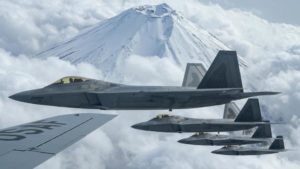

David Axe – June 7, 2021
For years, the U.S. Air Force concentrated its warplanes at just two bases in the western Pacific: for fighters, Kadena Air Force Base in Japan’s Okinawa prefecture; and for bombers and big support planes, Guam’s Andersen Air Force Base.
Beijing eyed these mega-bases and devised a simple strategy for suppressing U.S. air power in the region. Build a couple thousand non-nuclear ballistic missiles and, in wartime, lob them at the bases until their runways, aprons, hangars, fuel tanks and warehouses are nothing but craters.
After years of build-up, the Chinese rocket force possesses around 1,300 ground-launched missiles with sufficient range to hit Kadena and Andersen from mainland China.
The USAF is keenly aware of the threat. It has its own plan for dodging the missile barrages. The idea is to spread out hundreds of warplanes across potentially dozens of smaller bases—thus diluting the striking power of China’s rocket force.
The Air Force won’t say exactly which bases are part of its plan, but it’s possible to make educated guesses. American territories and small island countries offer the most dependable facilities. Arguably the most important bases—in the Philippines—are accessible only at the whim of that country’s mercurial president.
The emerging map of the USAF’s expanding base network also reveals where the service has potential airfield gaps, most glaringly in the Philippine Sea east of Taiwan. In that gap, the U.S. Navy’s Pacific Fleet might lend its sister service a helping hand—and deploy some of its 10 aircraft carriers and big-deck assault ships.
The Air Force maintains a master list of what Gen. Kenneth Wilsbach, the head of Pacific Air Forces, described as “every single piece of concrete” in the Pacific region.